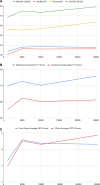BioInstruct: instruction tuning of large language models for biomedical natural language processing
- PMID: 38833265
- PMCID: PMC11339494
- DOI: 10.1093/jamia/ocae122
BioInstruct: instruction tuning of large language models for biomedical natural language processing
Abstract
Objectives: To enhance the performance of large language models (LLMs) in biomedical natural language processing (BioNLP) by introducing a domain-specific instruction dataset and examining its impact when combined with multi-task learning principles.
Materials and methods: We created the BioInstruct, comprising 25 005 instructions to instruction-tune LLMs (LLaMA 1 and 2, 7B and 13B version). The instructions were created by prompting the GPT-4 language model with 3-seed samples randomly drawn from an 80 human curated instructions. We employed Low-Rank Adaptation (LoRA) for parameter-efficient fine-tuning. We then evaluated these instruction-tuned LLMs on several BioNLP tasks, which can be grouped into 3 major categories: question answering (QA), information extraction (IE), and text generation (GEN). We also examined whether categories (eg, QA, IE, and generation) of instructions impact model performance.
Results and discussion: Comparing with LLMs without instruction-tuned, our instruction-tuned LLMs demonstrated marked performance gains: 17.3% in QA on average accuracy metric, 5.7% in IE on average F1 metric, and 96% in Generation tasks on average GPT-4 score metric. Our 7B-parameter instruction-tuned LLaMA 1 model was competitive or even surpassed other LLMs in the biomedical domain that were also fine-tuned from LLaMA 1 with vast domain-specific data or a variety of tasks. Our results also show that the performance gain is significantly higher when instruction fine-tuning is conducted with closely related tasks. Our findings align with the observations of multi-task learning, suggesting the synergies between 2 tasks.
Conclusion: The BioInstruct dataset serves as a valuable resource and instruction tuned LLMs lead to the best performing BioNLP applications.
Keywords: information extraction; instruction tuning; large language models; multi-task learning; natural language inference; question answering; text generation.
© The Author(s) 2024. Published by Oxford University Press on behalf of the American Medical Informatics Association. All rights reserved. For permissions, please email: journals.permissions@oup.com.
Conflict of interest statement
The authors declare no competing interests.
Figures



Similar articles
-
Advancing entity recognition in biomedicine via instruction tuning of large language models.Bioinformatics. 2024 Mar 29;40(4):btae163. doi: 10.1093/bioinformatics/btae163. Bioinformatics. 2024. PMID: 38514400 Free PMC article.
-
Resource-efficient instruction tuning of large language models for biomedical named entity recognition.J Biomed Inform. 2025 Aug 21;170:104896. doi: 10.1016/j.jbi.2025.104896. Online ahead of print. J Biomed Inform. 2025. PMID: 40849052
-
Evaluating and Improving Syndrome Differentiation Thinking Ability in Large Language Models: Method Development Study.JMIR Med Inform. 2025 Jun 20;13:e75103. doi: 10.2196/75103. JMIR Med Inform. 2025. PMID: 40540614 Free PMC article.
-
Examining the Role of Large Language Models in Orthopedics: Systematic Review.J Med Internet Res. 2024 Nov 15;26:e59607. doi: 10.2196/59607. J Med Internet Res. 2024. PMID: 39546795 Free PMC article.
-
Applications and Concerns of ChatGPT and Other Conversational Large Language Models in Health Care: Systematic Review.J Med Internet Res. 2024 Nov 7;26:e22769. doi: 10.2196/22769. J Med Internet Res. 2024. PMID: 39509695 Free PMC article.
Cited by
-
The Development Landscape of Large Language Models for Biomedical Applications.Annu Rev Biomed Data Sci. 2025 Aug;8(1):251-274. doi: 10.1146/annurev-biodatasci-102224-074736. Epub 2025 Apr 1. Annu Rev Biomed Data Sci. 2025. PMID: 40169010 Free PMC article. Review.
-
BioMistral-NLU: Towards More Generalizable Medical Language Understanding through Instruction Tuning.AMIA Jt Summits Transl Sci Proc. 2025 Jun 10;2025:149-158. eCollection 2025. AMIA Jt Summits Transl Sci Proc. 2025. PMID: 40502228 Free PMC article.
-
Dynamic few-shot prompting for clinical note section classification using lightweight, open-source large language models.J Am Med Inform Assoc. 2025 Jul 1;32(7):1164-1173. doi: 10.1093/jamia/ocaf084. J Am Med Inform Assoc. 2025. PMID: 40460022
-
A novel recommender framework with chatbot to stratify heart attack risk.Discov Med (Singap). 2024;1(1):161. doi: 10.1007/s44337-024-00174-9. Epub 2024 Dec 17. Discov Med (Singap). 2024. PMID: 39759423 Free PMC article.
-
MedReadCtrl: Personalizing medical text generation with readability-controlled instruction learning.medRxiv [Preprint]. 2025 Jul 11:2025.07.09.25331239. doi: 10.1101/2025.07.09.25331239. medRxiv. 2025. PMID: 40672473 Free PMC article. Preprint.
References
-
- Brown TB, Mann B, Ryder N, et al. Language models are few-shot learners. In: Larochelle H, Ranzato M, Hadsell R, Balcan MF, Lin H, eds. Advances in Neural Information Processing Systems. Vol 33. 2020:1877-1901. https://proceedings.neurips.cc/paper/2020/file/1457c0d6bfcb4967418bfb8ac....
-
- Sanh V, Webson A, Raffel C, et al. 2021. Multitask prompted training enables zero-shot task generalization. CoRR; abs/2110.08207. https://arxiv.org/abs/2110.08207.
-
- Chowdhery A, Narang S, Devlin J, et al. 2022. PaLM: scaling language modeling with pathways. arXiv, arXiv:220402311, preprint: not peer reviewed. https://arxiv.org/abs/2204.02311.
-
- Longpre S, Hou L, Vu T, et al. 2023. The flan collection: designing data and methods for effective instruction tuning. https://arxiv.org/abs/2301.13688.
-
- OpenAI. 2023. GPT-4 Technical Report. arXiv, arXiv:230308774, preprint: not peer reviewed. https://api.semanticscholar.org/CorpusID:257532815.
MeSH terms
Grants and funding
LinkOut - more resources
Full Text Sources

